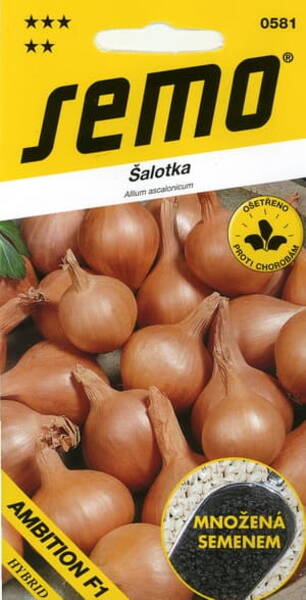Forms bigger, in contrast to the mother onion plant one-piece onions of fine and sweety taste. The merely by seed multiplied variety is virusless. We need cca 4,5-5,5 g seed for 10 m2. Requires protection by fungicides against the onion mould from mid June.
* A very useful and valuable type of onion is the scallion, which is valued for its good yield, early ripening, high taste and ability to be stored in the room for a long time; it practically does not bolt.
Scallion have a large number of bulbs in one nest: they are smaller than hibernal onions, but they differ from their larger counterpart in the most refined taste and ability to be stored in the house all winter without losing their commercial qualities.
A scallion braid can be hung right in the kitchen: in winter, the decoration and onions are always at hand.
Another important quality of scallion is that their feathers are thinner and more delicate, which do not become coarse throughout the growing season. And it appears much earlier than onions.
Scallion are a rare guest in our gardens. In Western Europe and Scandinavian countries, this onion is highly valued for its sharp-sweet taste and higher medicinal properties than hibernal onions.
There are many varieties of scallion. There are white, red, purple, yellow, brown and the shape of the bulbs is elongated, round, rounded-flat, depending on the variety.
Before you start planting scallion, prepare the bed in advance and, the day before planting, prepare the planting material. In order for the shallot to grow large, the scallion bulb is divided into several parts. Cut off the top and cut into several parts along the “eyes”. 1 bulb produces 3-8 planting units. Planted in early April in prepared furrows at a distance of 15-16 cm in a row and 30 cm between rows.
So, while the onions in the garden are growing and gaining strength, as needed, where there are more than 3 pieces in the nest, they pull out one section at a time until 1-2 onions remain in the nest. This must be done carefully, holding with your hand the bulbs intended for further growth. The whole process of removing excess onions is gradual - you need onions for cooking, so pull as much as necessary.
Usually, onion breaking begins more than 1.5 months after the onion sprouts, so that the onion begins to divide and is easily separated from the common bulb. By the time of harvesting, the remaining bulbs are very large, and there are no small things in the nests. The best predecessors for it are beans, peas, carrots or potatoes. Prepared compost is added to the garden bed - this technique allows you to do without fertilizing.
To protect against onion flies, sprinkle the beds generously with ash.
Scallion love moisture and a weed-free environment.
If suddenly the tops of the leaves begin to dry out and light stripes form on them, and there are small worms inside the feathers, then water the scallion with a solution of table salt (1 glass per 10 liters of water).
As soon as the leaf begins to lie down, the onions are no longer watered. Shallots ripen earlier than onions, so they can be grown in areas with a short growing season, where onions do not have enough time to ripen.
Unlike hibernal onion, they can be planted in the fall, like winter garlic. Then it is ready for harvesting 10-15 days earlier than during spring planting. This is another positive quality of scallion that allows it to be grown in the northern regions. When the leaf begins to dry out, rake away the soil so that the bulbs are on the surface.
If the weather permits, then after harvesting the bulbs are dried in the garden bed. The onions are dried under a canopy.
Gourmets love to use it instead of hibernal onions.
The delicate taste of the green feather grown from this onion is also appreciated.
Peeling scallion can be difficult, but if you pour boiling water over them for a few minutes, the peel will come off very easily.
Eng.: Scallion. Bot.: Allium cepa L. var. ascalonicum.












